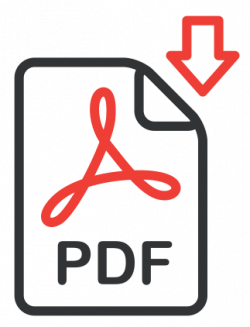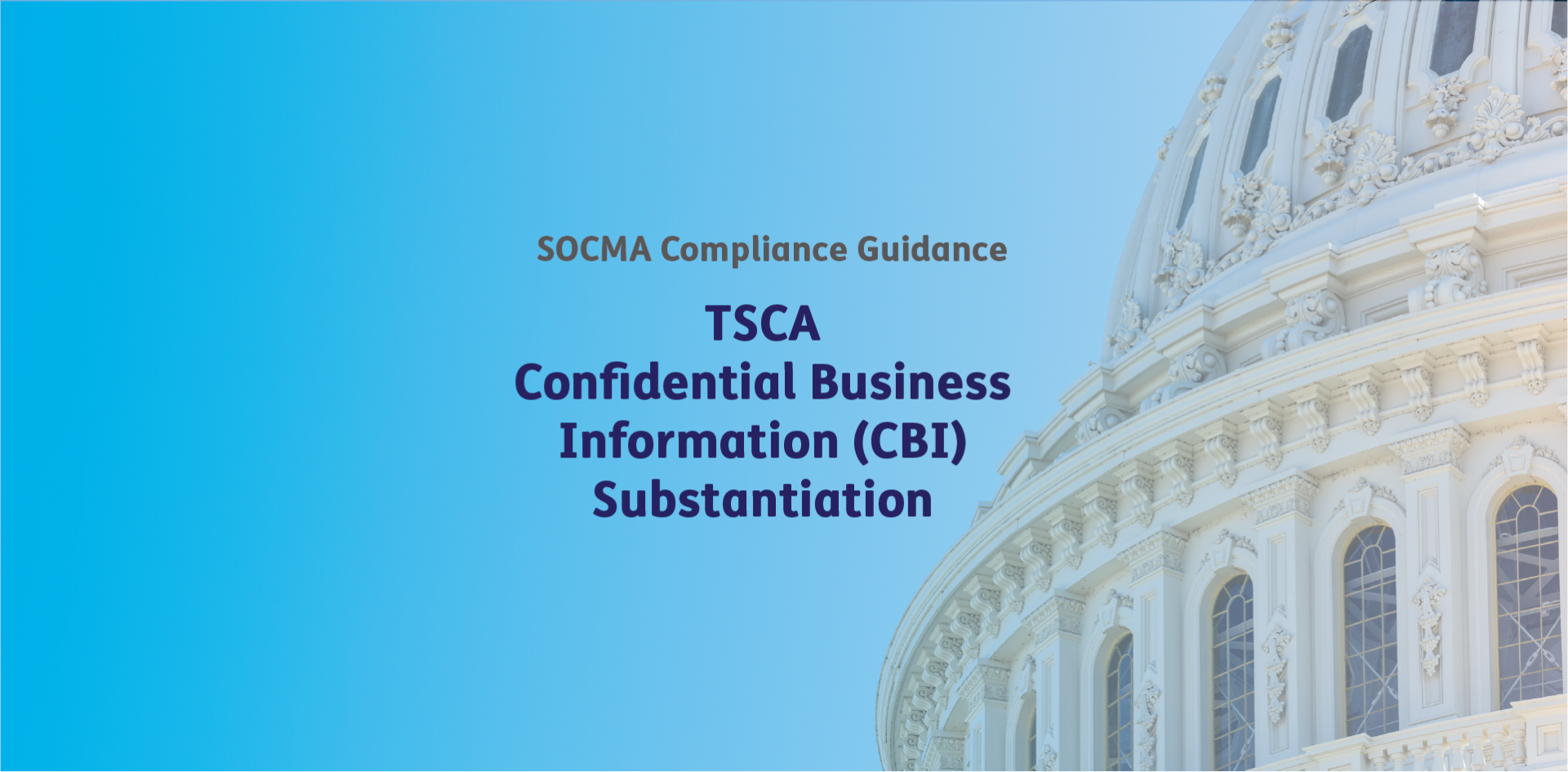
SOCMA Compliance Guidance: TSCA Confidential Business Information (CBI) Substantiation
March 17, 2020
|
The U.S. Environmental Protection Agency has finalized its procedural rule for the review of TSCA CBI claims.[1] The rule establishes substantiation requirements for manufacturers and processors who seek to maintain CBI claims for specific chemical identities listed on the confidential portion of the TSCA Inventory. The effective date for the rule is May 5, 2020. |
 Download Guide Download Guide |
What CBI Claims Does This Rule Apply To?:
This final rule applies to effectively all TSCA CBI claims, regardless of whether upfront substantiation has already been provided to EPA, or if you have a past claim already approved by the Agency. Companies that wish to maintain a confidential chemical identity from a Notice of Activity (NOA) Form A or Form B or from Chemical Data Reporting (CDR) Form U or a Notice of Commencement (NOC) need to review their prior submissions to ensure they are responsive to this rule’s substantiation requirements.
A 2019 federal circuit court decision invalidated EPA’s decision to omit two CBI substantiation questions regarding reverse engineering from the final version of the TSCA Inventory Notification (Active-Inactive) Rule[2].
This action effectively made prior substantiations submitted to EPA during the TSCA Inventory reset deficient. Therefore, if you completed a voluntary substantiation under the TSCA Inventory Notification Rule, you must amend your submission to submit answers relevant to the newly added reverse engineering substantiation questions. EPA will allow submitters to rely on their previously submitted responses to the other substantiation questions.
CBI Substantiation Scenarios:
(1) If you filed an NOA Form A under the TSCA Inventory Notification Rule and claimed a chemical identity as confidential, you will have 180 days from the effective date of this rule to substantiate your claim. This applies to both voluntary upfront substantiations filed with the NOA Form A, or if you need to file a new substantiation consistent with this rule’s requirements. The deadline to file a substantiation under these scenarios is November 1, 2020.
(2) If you filed an NOA Form B under the Active-Inactive Rule, you must provide full substantiation on that form by the May 5, 2020 effective date. This includes any Form Bs submitted to EPA during the onetime TSCA Inventory transitional reporting period (between May 6, 2019 – August 5, 2019). After the effective date of this rule, any new Form B substantiations will be due within 30 days of the submission.
(3) If you previously substantiated a CBI claim for a chemical identity in a different submission made to EPA after November 1, 2015, you are allowed to rely on that prior substantiation. If you seek to rely on this exemption, you must report to EPA the submission date; submission type; and case number, transaction ID, or equivalent identifier for the submission in order to establish eligibility for the exemption and to ensure that EPA can locate and match your prior substantiation. This must be done by the November 1, 2020 deadline. EPA had previously described this exemption as being mainly applicable to claims made in conjunction with 2016 CDR reporting or NOCs for new chemicals, but given the deadlines in the final rule, it will also apply to 2020 CDR submissions.
CBI Duration of Protection:
After EPA approves a substantiated CBI claim, it will generally be protected from disclosure for a period of 10 years from the date on which the confidentiality claim was first asserted by any submitter. Exceptions to this period of protection from disclosure are: (1) if, prior to the expiration of the period, the claimant notifies EPA that the person is withdrawing the confidentiality claim, EPA will not protect the information from disclosure from that date forward; or (2) if EPA otherwise becomes aware that the information does not qualify for protection from disclosure.
In scenarios where more than one company claims the same specific chemical identity as confidential, EPA will grant the 10-year period of protection from the date on which the first claimant asserted the CBI claim. If one company does not adequately protect the identity from disclosure, none of the specific chemical identity CBI claims for any other companies would be supportable. EPA has asserted that CBI claims are chemical-specific (rather than specific to the claimant), and so as soon as one company fails to maintain a chemical identity as confidential, all claims of confidentiality for that identity are vitiated.[3]
Claims which EPA determines do not qualify for CBI protection will be publicly disclosed, with the claimants given a 30-day notice of intent by the Agency. The claimant’s only recourse to prevent the disclosure will be to challenge the decision in federal district court.
Substantiation Considerations:
Companies interested in maintaining a CBI claim must be ready to complete substantiation questions that assess how difficult it would be to determine the identity of a substance using current technological methods and an explanation of the competitive harm effects triggered by disclosure.
EPA states that, when substantiating the reverse engineering questions, companies should consider an assessment of the current status of available technologies in analytical chemistry and readily available equipment, and should also consider the cost, effort, time, and typical laboratory procedures necessary for successful reverse engineering under reasonable efforts.
For evaluating competitive harm, EPA states that companies can consider, among other things, “substantial damage to the company’s revenue; profitability; market share; return on investment for manufacturing the confidential chemical substance; motivation for investing in technological innovation; or any other objective source of harm to the company’s ability to compete in the marketplace for the goods or services that use the chemical substance at issue.”
While the second reverse engineering question ((8) below) appears more detailed than previous formulations, EPA has stated that the changes “do not indicate a substantive change to the standard that has been applied under the Chemical Data Reporting or Notice of Commencement regulations, which served as the model for the proposed substantiation question.”
CBI Substantiation Questions:
(1) Will disclosure of the information claimed as confidential likely cause substantial harm to your business’s competitive position? If you answered yes, describe the substantial harmful effects that would likely result to your competitive position if the information is disclosed, including but not limited to how a competitor could use such information and the causal relationship between the disclosure and the harmful effects.
(2) To the extent your business has disclosed the information to others (both internally and externally), has your business taken precautions to protect the confidentiality of the disclosed information? If yes, please explain and identify the specific measures, including but not limited to internal controls, that your business has taken to protect the information claimed as confidential.
(3) (i) Is any of the information claimed as confidential required to be publicly disclosed under any other Federal law? If yes, please explain.
(ii) Does any of the information claimed as confidential otherwise appear in any public documents, including (but not limited to) safety data sheets; advertising or promotional material; professional or trade publications; state, local, or Federal agency files; or any other media or publications available to the general public? If yes, please explain why the information should be treated as confidential.
(iii) Does any of the information claimed as confidential appear in one or more patents or patent applications? If yes, please provide the associated patent number or patent application number (or numbers) and explain why the information should be treated as confidential.
(4) Is the claim of confidentiality intended to last less than 10 years? If yes, please indicate the number of years (between 1-10 years) or the specific date/occurrence after which the claim is withdrawn.
(5) Has EPA, another Federal agency, or court made any confidentiality determination regarding information associated with this chemical substance? If yes, please provide the circumstances associated with the prior determination, whether the information was found to be entitled to confidential treatment, the entity that made the decision, and the date of the determination.
(6) Is the confidential chemical substance publicly known (including by your competitors) to have ever been offered for commercial distribution in the United States? If yes, please explain why the specific chemical identity should still be afforded confidential status (e.g., the chemical substance is publicly known only as being distributed in commerce for research and development purposes, but no other information about the current commercial distribution of the chemical substance in the United States is publicly available).
(7) Does this particular chemical substance leave the site of manufacture (including import) or processing in any form, e.g., as a product, effluent, or emission? If yes, please explain what measures have been taken, if any, to guard against the discovery of its identity.
(8) If the chemical substance leaves the site in a form that is available to the public or your competitors, can the chemical identity be readily discovered by analysis of the substance (e.g., product, effluent, or emission), in light of existing technologies and any costs, difficulties, or limitations associated with such technologies? Please explain why or why not.
[1] 85 FR 13062 (March 6, 2020).
[2] 82 FR 37520 (August 8, 2017).
[3] In the Response to Comments document for the CBI procedural rule (p. 19), EPA says: “Companies that wish to protect the connection between the specific chemical identity and other information in a submission (for example, the connection between a company name or site and the chemical substance, or specific information regarding the use, function, or application of a chemical substance or mixture in a process, mixture, or article) need to claim that specific information as CBI rather than (or in addition to) chemical identity.”
Categorized in: Policy, Toxic Substances Control Act
